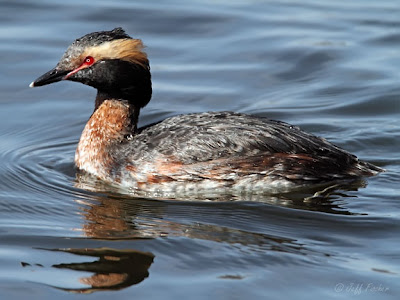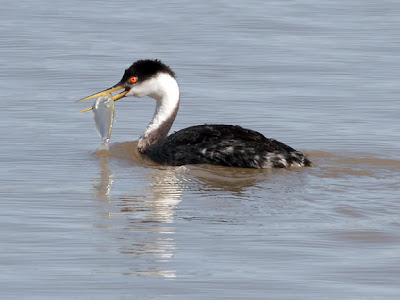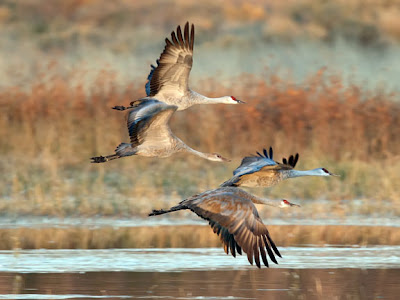The pileated woodpecker is the largest woodpecker species in North America. That is if the ivory-billed woodpecker is extinct. This crow sized woodpecker bores rectangular holes into trees and other wood in search of ants and other insects. The holes that they create are so large that they often attract other woodpeckers and birds that feed of insect or use the space as a nesting cavity. They are found through out the eastern half of the United States, southern Canada, and the west coast of the United States. They are not migratory so they stay on their breeding territory all year long.
Tuesday, April 30, 2013
Monday, April 29, 2013
Lake Hiawatha
So after a very long winter this weekend's weather was almost perfect, at least on my scale. We had mostly sunny days with highs in the lower to mid seventies. Since it is almost May I went out to a few of my favorite places to see if I could find some early warblers. The only warblers that I found were yellow rumps but I did find a lot of the migrating waterfowl was still around. Most of the time they would have moved on by now but because of our longer then normal winter many of the lakes up north still have ice on them. So many of the migrating waterfowl are holding tight until things get better up north.
The best place that I found for photographing migrating waterfowl was Lake Hiawatha. This lake in south Minneapolis is one of several that is fed from Minnehaha creak. Since it is smaller then many of the other lakes around, it is usually where the ice melts first. This open water attracts migrating waterfowl who stop to feed on fish from the lake including northern pike, walleye and large mouthed bass. In 1922 when the lake property was purchased by the City of Minneapolis, Lake Hiawatha was just a swamp but the city transformed it over a number of years into a beautiful lake surrounded by a park and golf course. This year the lake had a number of common loons which is not uncommon but there was also a number of horned grebe in their breeding plumage. I took advantage of the rare opportunity to get a lot of horned grebe pics before they head up to their breeding grounds up in Canada. I also spotted bufflehead, common, hooded, and red-breasted mergansers, pied-billed grebe and numerous species of ducks. There was also a few eagles that circled above the lake for a few minutes and osprey diving into the lake after fish.
Sunday, April 28, 2013
Monarch Caterpillar
The larval form of the monarch, or caterpillar as it is more commonly called, lives by eating various forms of milkweed plant. The come from an egg that is about the size of a pinhead that is laid on the underside of a milkweed leaf. The small caterpillars begin by eating the leaf that the egg was attached to. As they eat they grow and develop, shedding their skin numerous times. Each one of these developmental periods is called an instar. The sap from the milkweed is toxic to many insects and birds which makes the monarch rather unpalatable to most predators. The plant that this caterpillar is chewing on is commonly called butterfly weed and it is a species of milkweed.
Saturday, April 27, 2013
Lightning Strikes!
The weather this weekend has been wonderful so I have sent most of it outside. Despite the fact that up until mid week we had lots of snow on the ground and ice on the water I still got some great pics. This afternoon I noticed that Lock and Dam number one was open, It was closed when I checked last weekend, so I decided to check and see if there were any peregrine falcons at the nest box. I was excited to find a female sitting on the nest box. Unfortunately she was faced the wrong way so I had to hike up the hill to get a shot that included her bands so that I could identify her. About 80% of the peregrine population in this area have been banded by the Midwest Peregrine Foundation and they keep a database so that if you get the band number you can look them up. This bird is named lightning and she was hatched near the St Croix River in 2007. After a while her partner came over and brought her food. I was able to get a good view of his legs and I saw that he was not banded. This will be the four year that I have watched this nest box. Last year the nest did not have any falcons so I am hopeful that this year lightning will strike and she and her unbanded mate will have a good brood of chicks.
Friday, April 26, 2013
Thursday, April 25, 2013
After the Snow
Our winter storm warning at the beginning of the week was not as bad ad they were predicting but we still got a couple inches of fresh snow. I went out with my camera the next day to get some pictures of the snow which was clinging to just about everything. A couple of days later most of the snow is gone.
Wednesday, April 24, 2013
First warbler of the year.
While I was out photographing the fresh snow yesterday I caught a glimpse of my first warbler of 2013. The yellow-rumped warbler is typically the first warbler that we see in the spring and the last we see in the fall. The reason for this is because most warblers are insect eaters so during the winter they migrate south to where they can find food. Yellow-rumps do not migrate as far south because they can eat several different types of berries that other warbler species cannot digest. This allows them to survive further north during the winter. It also lets them arrive earlier then other warblers and leave later in the fall. Unfortunately I did not have my birding lens with me so I did not get a picture, this is one from a couple years ago, but i am hoping to get out and spot some warblers this weekend as our temps are supposed to finally get up into the 70s.
Tuesday, April 23, 2013
Orange-crowned Warbler
For a bird with such a colorful name the orange-crowned warbler is rather plain. They do have an orange patch of feathers on the top of their head but it is usually not visible.These birds breed in Canada, Alaska and parts of the western United States. Their numbers in the eastern portions of North America are in decline. They winter in the southern US, Mexico and Central America.
Monday, April 22, 2013
Minnehaha Falls
Minnehaha Falls is a popular landmark in south Minneapolis. The Minnehaha Creek begins at Lake Minnetonka in the western suburbs of Minneapolis and weaves its way through the south west suburbs connecting several lakes along the way. At the falls the creek dramatically plunges 53 feet before resuming its path to the Mississippi which is only about a mile away. During the winter the falls is mostly frozen and parts of the park surrounding the falls is closed. As you can see from this photo that I took Saturday the water is open on the falls even though there is still a lot of ice around.
Happy BirthDay
Today, April 22, is Earth Day. It's a special day where we show our appreciation for the natural world and are more aware of the things that we need to do to preserve it.On Earth Day 2007 I began the Ecobirder Blog. During the past six years there have been good times and bad times, there have been days where I could not wait to share pictures and posts and days where it took almost every thing that I had to write a post for the day. During all this time many of you have visited often and left comments and encouragements for which I would like to thank you. With out you this blog would not be here. It has become kind of a tradition to share pics from the calendars that I make each year on this special day. So keeping with tradion here are the pictures from the 2013 Ecobirder Calendar.
Great Sand Dunes National Park, CO
Ferruginous pygmy owl San Miguelito Ranch, Tx
Altamira oriole at Bentsen State Park, Tx
Sandhill crane colt Necedah NWR, Wi
Western grebe Bosque del Apache, NM
Cabbage white butterfly River Bend Nature Center, MN
Red-headed woodpeckers Necedah NWR, Wi.
Pied-billed grebe Crex Meadows, Wi
Black Bear Vince Shute Wildlife Sanctuary, MN
Gulf Fritillary Santa Ana NWR, Texas.
Sandhill cranes Boque del Apache, MN
Northern Saw-whet owl Dodge Nature Center, MN
Thanks for a great year!
Sunday, April 21, 2013
One of These Things is not Like the Other!
At first glance this may appear to be two pictures of monarch butterflies. However these are actually pictures of two different butterfly species. In fact these two species are not even in the same genus. The photo above is of a viceroy butterfly, Genus Lemenitis, while the one below is a monarch, Genus Danaus.
Besides the fact that they look similar these two butterflies have very little in common. Both are members of the Nymphalidae , or brushfoot, family, but many species are brushfoot butterflies. The monarch butterfly is what is commonly referred to as a milkweed butterfly. These are species that eat milkweed during their larval stage making them toxic to many predators. Some people believe that the viceroy may be avoided by predators because of its resemblance to the monarch. However it has been proven that the viceroy may itself possess acids that make them taste bitter, which helps keep them from being eaten. Perhaps they are both orange as a warning to anything that is hungry and does not know any better.
Saturday, April 20, 2013
Common Loon
The sun finally came out today. It is hard to believe that it is already the last half of April. You would not know it from looking outside. The fresh snow that we got Thursday and Friday makes it look like early March. Even with our continuing winter weather some of the birds have begun to come back into the area. I spotted a half a dozen loons on Lake Hiawatha today.Unfortunately for the loons there was a lot more ice on the lake then usual so they were limited in where they co swim. Last year, at this time, you could not find a lake with ice still on it and this year its hard to find a lake that doesn't. For the loons this is just a stop over on their way north but if we still have a lot of snow and ice here then there is probably even more further north. So perhaps these loons will be hanging around for a bit.
Friday, April 19, 2013
Eastern Amberwing
The eastern amberwing is the second smallest dragonfly in North America. I photographed this male on the vegetation mats at Purgatory Creek.
Thursday, April 18, 2013
Hawaiian Hills
Back in 2002 we went on a two week trip to Hawaii. Hawaii was not my first choice of locations but since Michelle has indulged my dragging her to many out of the way locations on trips I decided to surprise with a trip to somewhere that she wanted to go. I was pleasantly surprised. There was a good amount of interesting wildlife, since many of the species had adapted over centuries of exclusion. I also had a blast searching the tide pools for interesting creatures and the scenery, like the view above, was incredible.
Wednesday, April 17, 2013
Snow Geese
Snow geese breed up in the arctic and subarctic tundra of Canada and Alaska. They usually nest close to a pond, lake or near the coast. They look for nesting areas that lose their snow early so that they can avoid some of the flooding that comes from the spring thaw. They winter primarily in coastal areas of the US and Mexico, although there is a large population that migrates to the south central US to places such as the Bosque del Apache where this photo was taken. They often stop to feed at farm fields during migration.
Subscribe to:
Posts (Atom)





















































